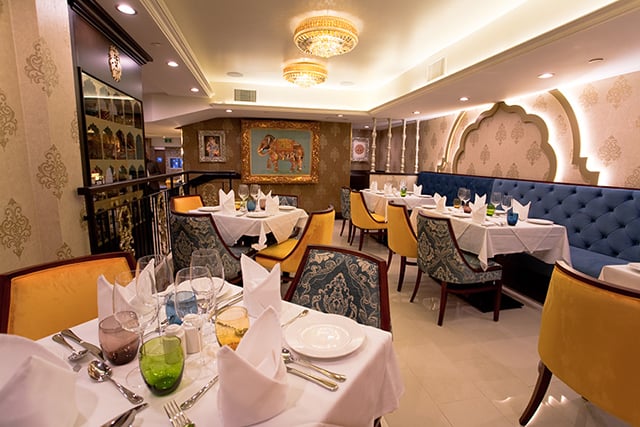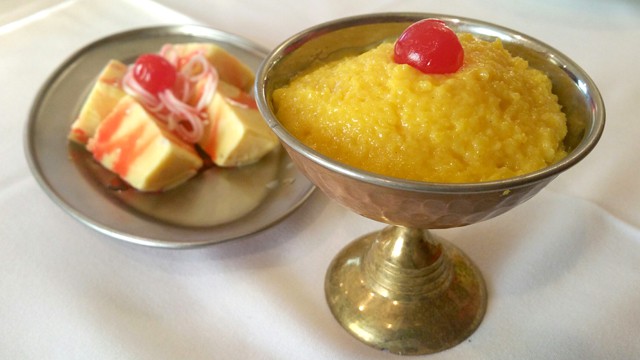3 Month Review: The Maharaja
Published June 3, 2016 at 10:03 pm

First Impression:
The Maharaja is an incredibly stunning boutique restaurant inspired by the regal beauty of India’s diverse landscape of architecture and flavours. The concept offers a visual and culinary journey through three magnificent palaces of India and a menu featuring cuisine from four different regions in the country. Located in a heritage building over a century old and formerly The Mad Hatter along Eglinton Ave. and Heritage Hills Blvd., the restaurant was completely gutted and the transformation breathtaking.

The Good:
“…the creativity behind the dishes and the story for each …made the food look like art.”
No doubt the food was better than good — it was exceptional. Not only the taste, but the creativity behind the dishes and the story for each (along with the plating) made the food look like art. I actually felt bad eating the entire dish because it was so visually stunning. You can see for yourself how gorgeous the presentation was.

The Unique:
“The host actually takes you on a tour of the restaurant before you even get seated.”
The host actually takes you on a tour of the restaurant before you even get seated, which is unique and generally a nice touch, but could annoy diners who are anxious to order food. The restaurant takes you through a journey of three of India’s palaces starting with Hawa Mahal (Palace of Wind), located in Jaipur. It’s an elevated room on the right side of the restaurant that is bright and airy. The Sheesh Mahal (Palace of Mirrors), located in Pakistan, is the largest of the three rooms, located in back of the restaurant and decorated with intricate lattice mirror walls and chandeliers. Lastly, Rang Mahal (Palace of Colour) located in Dehli, is a room on the left side of the restaurant that represents the diversity of colours and cultures in India. The beautifully lit bar located in the centre of the restaurant is made of a single piece of hand-crafted luminescent honeycomb onyx from Pakistan.

The storybook menu is divided into four regional cuisines found in India that have been influenced by various ingredients and flavours of a variety of regions, including Greece, West and Central Asia and Persia. There are a number of shareable dishes and entrees highlighting the unique flavours of each region through Awadhi cuisine, classic Hyderabadi cuisine, Punjabi cuisine and Rajputana cuisine. The extensive menu caters to all palates and features distinct regional dishes presented on fine dishware such as copper bowls, slate boards and a copper table top grill.

What they can improve on:
The service is good, but not quite the calibre one might expect from a fine-dining establishment (and this resto should absolutely be viewed as a fine dining hotspot). In my experience, some ethnic restaurants are known to place less emphasis on service. They focus on food above all else. Serving at a fine dining resto is challenging because there’s a lot more involved. It’s almost an art form and one that the owners have to teach and the servers practice.
Our server was really friendly and knew the menu (the menu is massive), but the system the operators have in place for serving makes the service slow. When we first arrived, it was fine because it was just us in the restaurant. Once other parties started rolling in and a table of eight was seated, he was still alone. At the Maharaja, the server brings a dish and then places it on your plate one item at a time. It took the server over 10 minutes to serve every diner at the larger table and during that time, our empty plates sat in front of us uncollected. The server also has to explain the expansive, dictionary-length menu and that takes time. It was not the server’s fault that everything was taking too long, but the long wait should compel operators to tweak their system or ensure they have the appropriate amount of servers working.

What we tried:
For apps, we went all out and got the most expensive dish on the menu: the Amira Shaan Lobster ($39.99). The dish is two slow-cooked lobsters that have been treated with cumin, spiced yoghurt and lemon juice. It was lobster like I have never had before. It had a kick that was just right without being too much and was absolutely delicious.

For our main entrees, we asked the server what he recommended and he told us right away it was the Koe E Awadh ($29.99), which were two lamb shanks braised in gravy. They were fall of the bone tender and melted in my mouth.

We, of course, had to try out the butter chicken, which is on the menu as Chooza Makhani ($15.99) and I have to say that this was one of the best butter chickens I have ever had. It was so flavourful without being too much and the texture was so light and fluffy. Sometimes butter chicken can get too soupy and this was not. The chicken chunks were generous and hearty, so there was no worrying about whether or not we’d still by hungry by the time we finished the dish. It was a perfect balance of everything butter chicken should be.

And of course we had some garlic naan, which was perfect to create butter chicken sandwiches with J
We also tried two desserts: Lab E Mashookh ($5.99) which is Kulfi served with rice vermicelli and rose syrup and the Biranj-e-Amba ($5.99), which is mango flavoured rice pudding with some rose and saffron. Both desserts were very unique on the taste buds.


Final Thought:
“Not only just an Indian restaurant experience, but a culinary experience that anyone can and should enjoy and try!”
I love when restaurants are completely unique in the Mississauga restaurant scene and Maharaja is definitely a unique gem. Not only just an Indian restaurant experience, but a culinary experience that anyone can and should enjoy and try! With little hiccups on the service side that can be fixed, this place is one of the restaurants you have to try in Mississauga!

Click here for map and contact info>
INsauga's Editorial Standards and Policies









